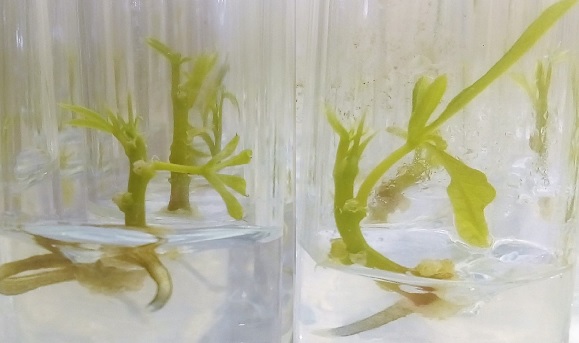Different concentrations of naphthaleneacetic acid in the in vitro establishment of cassava
DOI:
https://doi.org/10.20873/jbb.uft.cemaf.v8n4.martinsKeywords:
micropropagation, Manihot esculenta, phytoregulatorsAbstract
Cassava culture has high socioeconomic relevance for Brazil. However, in the western region of Pará, the spread of pests and diseases, among other factors, has limited root production. In this way, micropropagation becomes an alternative to traditional cultivation methods for obtaining material with phytosanitary quality. The objective of this study was to evaluate the effect of different concentrations of naphthalene acetic acid (ANA) in the in vitro establishment of stem apexes of the cassava variety Água Morna. The stem apexes were introduced into MS medium, supplemented with 0.04 mg L‑1 of 6-benzylaminopurine, 0.05 mg L‑1 of gibberellic acid and different concentrations of ANA (0.00 mg L‑1; 0.01 mg L‑1; 0.02 mg L‑1 and 0.03 mg L‑1). The experimental design was completely randomized, with five treatments, containing five replicates of five tubes each. Over 30 days, the height of the seedlings, number of green and dead leaves, number of roots and the length of the largest root were evaluated. The seedlings showed average values of 1.51 cm in height, 1.51 green leaves, 1.67 roots and 1.31 cm in length from the largest root. The control treatment provided the least number of dead leaves, with an average of 0.52 leaves. There were no significant differences between ANA concentrations for the other variables analyzed, except for the number of dead leaves. Therefore, the in vitro establishment of the Água Morna cassava variety was efficient in all treatments, and the culture medium without growth regulators could be used.
References
Alves RNB, Modesto Júnior MS, Andrade ACS. O trio da produtividade na cultura da mandioca estudo de caso de adoção de tecnologias na região no Baixo Tocantins, Estado do Pará. Congresso da associação brasileira das instituições de pesquisa tecnológica. Campina Grande, PB. 2008.
Boas SAV, Hohenfeld CS, Oliveira SAS, Santos VS, Oliveira EJ. Sources of resistance to cassava root rot caused by Fusarium spp.: A genotypic approach. Springer Nether-lands. Euphytica, v.209, n.1, p.237–251, 2016.
Cid LPB, Teixeira JB. Explante, meio nutritivo, luz e tempera-tura. In: CID, LPB. Cultivo in vitro de plantas. 3. ed. Ampl. - Brasília, DF: Embrapa, p.17-51, 2014.
Faye A, Sagna M, Kane PD, Sane D. Effects of different hormones on organogenesis in vitro of some varieties of cassava (Manihot esculenta Crantz) grown in Senegal. Afri-can Jounal of Plant Science, v.9, p.305-312, 2015.
Ferreira CF. Molecular characterization of cassava (Manihot esculenta Cranz) with. Ferreira, Daniel Furtado. Sisvar: a computer statistical analysis system. Ciência e Agrotecnolo-gia (UFLA), v.35, n.6, p.1039-1042, 2014.
Fialho JF, Vieira EA. Mandioca no Cerrado: Orientações técnicas. Planaltina, DF: Embrapa Cerrados. p.208, 2011.
Guimarães DG, Prates CJN, Cardoso AD. et al. Caracteriza-ção morfológica de genótipos de mandioca (Manihot escu-lenta Crantz). Scientia Plena, v.13, n.09, p.1-11, 2017.
Hartmann HT. et al. Plant propagation: principles and practic-es. New Jersey: Prentice-Hall, 7.ed. 880p. 2002.
Hora RAC, Souza AS, Silveira MS et al. Micropropagação de genótipos de mandioca via microestacas oriundas de diferen-tes posições da planta. In: Jornada Científica. EMBRAPA e fruticultura. 2015.
IBGE - Instituto Brasileiro de Geografia e Estatística / Sistema IBGE de Recuperação Automática – SIDRA. Área colhida, área plantada e produção, por ano da safra e produto das la-vouras. 2018. Disponível em: <https://sidra.ibge.gov.br/tabela/1612#resultado>. Acesso em 16 de março de 2018.
Kabir MH, Mamun ANK, Roy PK, Islam MR, Johan MT, Talukder SU. In vitro propagation of cassava (Manihot esculenta Crantz). Nuclear science and applications, v.24, n.1&2, p.23-28, 2015.
Kidulile CE, Alakonya AE, Ndunguru JA, Ateka EM. Cost effective medium for in vitro propagation of Tanzanian cas-sava landraces. African Journal of Biotechnology, v.17, p.787-794, 2018.
Murashige T, Skoog FA. A revised medium for rapid growth and bioassays with tobacco tissue culture. Physiologia Plantarum, v.15, p.473-497, 1962.
Saravanan R, Ravi V, Stephen R, Thajudhin S, George J. Post-harvest physiological deterioration of cassava (Manihot esculenta) – A review. Indian Journal of Agricultural Scien-ces, p.1383-1390, 2016.
Silva S, Ferreira FF, Gato AMG. Efeitos de diferentes concen-trações de 6-Benzilaminopurina no cultivo in vitro de Mani-hot esculenta Crantz. Scientia Amazonia, v.4, p.105-111, 2015.
Skoog F, Miller CO. Chemical regulation of growth and organ formation in plant tissues cultured in vitro. Symposium for the Society Experimental Biology, v.11, p.118-131, 1957.
Soares IA, Téo MS, Debastiani C, Retuci VS, Baroni, S. Concentrado proteico obtido das folhas de mandioca (Mani-hot esculenta Crantz) de três variedades de comerciais. Acta Ambiental Catarinense, v.13, p.1-7, 2016.
Souza, A. da S. (Ed.); Junghans TG. Aspectos práticos da micropropagação de plantas. Cruz das Almas: Embrapa Mandioca e Fruticultura Tropical, p.407, 2013.
Vidal AM. Micropropagação e embriogênese somática em variedades cultivadas de mandioca. Ano de obtenção:2009. 59p. Dissertação (Mestrado em Ciências Agrárias) – Uni-versidade Federal do Recôncavo da Bahia, Cruz das Almas.

Downloads
Published
How to Cite
Issue
Section
License
Copyright (c) 2024 - Journal of Biotechnology and Biodiversity

This work is licensed under a Creative Commons Attribution 4.0 International License.
Authors who publish with this journal agree to the following terms:
Authors retain copyright and grant the journal right of first publication with the work simultaneously licensed under a Creative Commons Attribution License (CC BY 4.0 at http://creativecommons.org/licenses/by/4.0/) that allows others to share the work with an acknowledgement of the work's authorship and initial publication in this journal.
Authors are able to enter into separate, additional contractual arrangements for the non-exclusive distribution of the journal's published version of the work (e.g., post it to an institutional repository or publish it in a book), with an acknowledgement of its initial publication in this journal.
Authors are permitted and encouraged to post their work online (e.g. in institutional repositories or on their website) prior to and during the submission process, as it can lead to productive exchanges, as well as earlier and greater citation of published work (Available at The Effect of Open Access, at http://opcit.eprints.org/oacitation-biblio.html).


